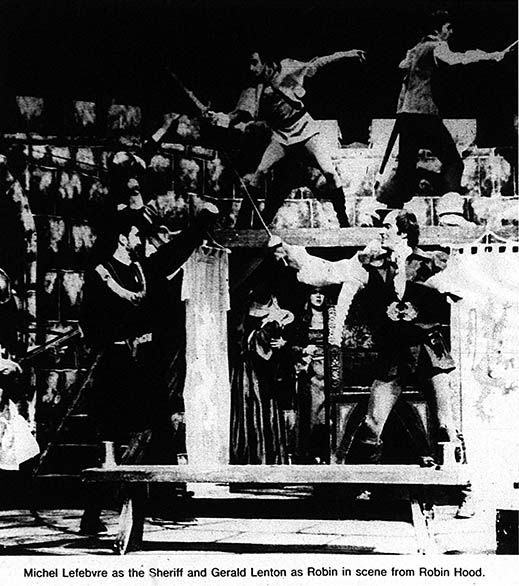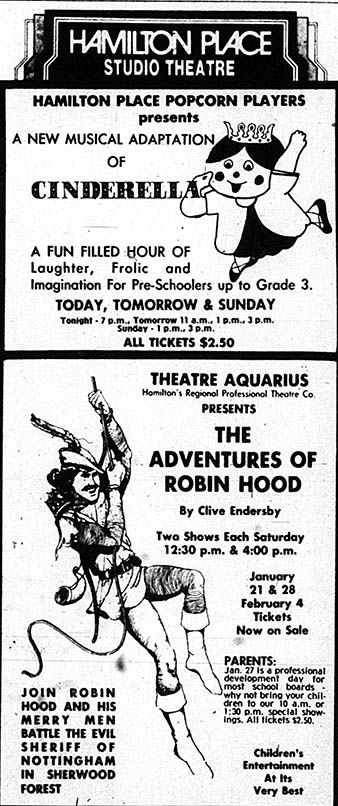Endersby and the Robin Hood Tradition
One aspect where the Robin Hood legend and pantomime coincide is in the tradition of cross-dressing. Endersby's play follows the ballad Robin Hood and Maid Marian (and several film and TV adaptations) by having Marian dress as a boy when she goes to meet Robin in the forest. Also, Friar Tuck and Little John are disguised as women in the play. Robin Hood himself was disguised as a woman in the ballad Robin Hood and The Bishop (Number 143 in Child's ballad collection) and in the 1973 Disney cartoon. But while the characters in the play disguise themselves as the opposite gender, the characters are all played by actors of the same gender. This wouldn't be the case in the true panto tradition where a leading male part (the principal boy), such as Robin or Alan, would be played by a girl, and a comic female role (the dame) would be played by a man in drag. The roles of the Sheriff''s Wife and Lady Priscilla are comic enough to fit within the dame tradition, if that had chosen to cast men for those roles.
The sheriff is also married in the ballads Robin Hood and the Potter and Robin Hood and the Butcher, although Endersby's play is one of the rare modern works to follow in that tradition. (Michael Cadnum's In a Dark Wood is another.) Many versions of the Robin Hood story give Marian a female companion such as a nurse. The most notable, perhaps, is Una O'Connor's Bess in the 1938 The Adventures of Robin Hood film. But with her physical prowess and tough attitude, the play's Lady Priscilla probably owes more to the Lady Cluck character from the 1973 Disney cartoon Robin Hood.
In her review, Wernick describes Marian as "written in such inconsequential and insipid fashion." That's a fair assessment which describes not only the Marian of Endersby's play but also the Marian of the 1973 Disney cartoon and the 1975 BBC mini-series The Legend of Robin Hood. Marian was lacking strength, especially compared to butt-kicking heroines such as The Bionic Woman and Wonder Woman on TV and Princess Leia on the big screen. The Marians of both previous and future TV shows, movies and books are more intelligent and capable than the Marians of the 1970s. For example, in the ballad, Marian was able to fight off Robin for over an hour, where as in the play she loses easily. Also, Maid Marian - often in boy's clothing - is one of the most capable Merry Men in the 1950s TV show, and as well as a spy in the sheriff's camp. The 2006 TV series features Marian as a cross-dressing superhero who'd been helping the poor and oppressed of Sherwood long before Robin started his outlaw career.
The play’s use of the Keeper folk music allows them to touch on the ballads at lightning speed. Little John and Friar Tuck's encounters come straight from the ballads Robin Hood and Little John and Robin Hood and the Curtal Friar. The Robin Hood stories have multiple characters named Will with a surname beginning with S. (Sometimes they are treated as different names for the same character, but other times there are multiple Wills in the band.) Will Scarlet is the best known, but Endersby opts for Will Stutely, and the song hints at the ballad Robin Hood Rescuing Will Stutly. Robin Hood stories from the 19th century onwards often feature Robin rescuing someone (sometimes Much the Miller's Son, a Merry Man from the early ballads who doesn't appear in this play) from foresters, and Endersby uses this as the background for Wat Taylor. The 19th century children's author Howard Pyle used the name Wat for the tinker when he adapted the Robin Hood and the Tinker ballad, but Endersby's Wat more likely owes his name to Wat Tyler, a leader of the real-life Peasants' Revolt of 1381. David of Doncaster doesn't have his story narrated in song, and Endersby doesn't feature the archery tournament from Robin Hood and the Golden Arrow, the ballad where David appears.
Alan-a-Dale also omits the story of his own first encounter with Robin, a tale which appeared in a popular ballad. While we might not learn his backstory, Alan is a prominent character in the play. He introduces the play, serving as a narrator and commentator on events. Allan-a-Dale played a similar role in the 1952 live action Disney film, The Story of Robin Hood and His Merrie Men, and the popular cartoon from 1973. The audience's immediate connection is with Alan. And then later, he's the one who knocks out the guards and devises the plan to rescue Robin. I remember as a child wanting to play Alan-a-Dale in our proposed children's play or home movie. Over the years I've assumed that I was passing over the more prominent Merry Men (in books, TV shows, etc) just because I (spelling differences aside) shared the name of Robin's minstrel. Looking at this play again, I now wonder if I was deliberately exploiting the similarity of name to secure the co-lead.
Endersby's Robin Hood is strictly a do-gooder -- the criminality of the medieval ballad figure had been well softened by a centuries-long career in children's entertainment. In her review in the Hamilton Spectator, Kathleen Wernick notices they called special attention to the fact that Robin was only stealing back what the sheriff's men had already stolen. Such a distinction was also made in the Robin Hood comics of the 1950s where a tax collector observes "Unless we get rid of Robin Hood, we'll never keep what we steal." The Disney films were cheekier about Robin's outlawry. In the 1973 cartoon, Robin says "We never rob. We just sort of borrow a bit from those who could afford it", and a skeptical Little John replies "Borrow? Hunh. Boy, are we in debt." The play is a bit too safe for such humour.
Still Endersby's Robin retains a lot of trickster charm. He cockily reveals his true identity to the dim-witted tax collectors. Robin and the Merry Men mock their enemies and outsmart them by the use of disguise. Whether for adults or children, humour is a necessary ingredient in the Robin Hood legend.ould all be the same Robin Hood.



Contact Us